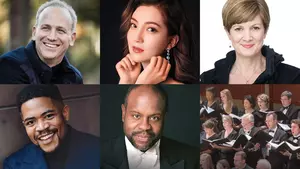The program presented by the Greensboro Symphony Thursday evening November 15 in War Memorial Auditorium was a study in contrasts of style and quantity linked only by rhythm. From chamber music employing eight violoncellos and a soprano in the first piece and some nineteen players in the second to the quantum jump of some 350 performers in the last piece was quite a progression. Conductor Stuart Malina excelled in the individual interpretations and in tying the whole event together as a celebration of life.
Bachianas Brasileiras No. 5, for soprano and eight violoncellos, opened the program with a rich display of sunny melodies and Latin rhythms. This is the most famous work by Brazilian composer Heitor Villa-Lobos and it incorporates his love of both Brazilian folk music and the polyphony of J.S. Bach. A richly varied texture is woven from the folk-like tunes and the complex rhythms. Set against this is the famous Aria the melody of which is a vocalization of “ah” with great amplitude. Verses by Ruth Valadares Correia describe the end of an afternoon. The first tempo returns and the vocalise should be done as a “bocca chiusa” as it was inspired by the wordless chorus from Puccini’s Madama Butterfly. The splendid soprano Sandra Lopez sang with great purity of tone and was successful in performing the vocalise as Eduardo Franscisco Alves has suggested Villa-Lobos wanted–by “emitting sound through the teeth [and] maintaining the characteristic tone of a closed mouth.” After some initial uncertainty, the cellos settled and gave a secure and vital performance. Principal cellist Beth Vanderborgh was outstanding in managing to bring out her solo line within the texture of the other cellos without creating the effect of a concerto soloist. This aspect is so rarely done successfully that it cannot be praised too much. Villa-Lobos would have been pleased with the whole effort and the care to realize his intentions.
Next came a good argument against traditional orchestras abandoning the Baroque repertory in the wake of the early-music-movement Puritans. Before the rise of the specialist chamber orchestras such as I Musici and the Academy-of-Saint Martin-in-the-Fields followed by the growth of “original instrument” groups, traditional symphony orchestras presented Baroque and early Classical music albeit with a heavy Romantic gloss and often with too many players. From a fine sounding harpsichord, Malina directed a very stylish performance of the Concerto Grosso from Handel’s Alexander’s Feast. Reduced forces were used–twelve violins, three cellos, a doublebass, an oboe and a bassoon–and the work was played without heavy Romantic vibrato–just crisp and elegant articulation. In contrast to the ripieno of the larger orchestra, which played the ritornello, the concertino consisted of Concertmaster John Fadial, Principal Second Violinist Steven B. Harper and Principal Cellist Beth Vanderborgh. Since Malina was often fully occupied with the continuo part, this was largely a well-rehearsed chamber music performance. I was surprised that I was able to hear most of the harpsichord part from left center row R.
After intermission the stage was packed. The 85-member Greensboro Symphony Orchestra was augmented with two pianists and extra strings and percussion. A number of UNCG Choruses had been combined along with the Burlington Boys Choir to make an estimated 330-350 performers. The joint work of some five choral directors and Malina led to a performance of remarkable clarity of Carl Orff’s “Carmina Burana.” Enough light had been left on to allow the audience to closely follow the text as it was sung. The sound of turning pages and appropriately timed laughter showed that they did so. The pure-voiced soprano roles were ably performed by Sandra Lopez. Counter-tenor Marshall Coid brought out the fiery situation of the roasting swan, the short but memorable 12th number. The scheduled baritone had been forced to cancel due to illness barely a day before the performance. A hurried search turned up a wonderful bass-baritone, Grant Youngblood, who was experienced in the part. He is truly a “native” North Carolinian being from Lumberton and of Lumbee Indian descent. His was the finest live performance of the lower voice parts that I have heard. In addition to a firm solid low sound, he was able to encompass the higher tessitura of the tenor voice that Orff demands of the bass-baritone. The driving rhythms were well maintained and a very wide dynamic range was fully exploited. The university choirs were wholly believable in the boisterous Tavern portion as well as the lusty “Court of Love” sequence. The very pure vocal line of Lopez brought out the full irony of No. 23 (“Sweetheart! Ah!/To you I give my all”). I would have never have believed that such a large chorus could execute such precise diction. It was a concert to remember, and it is too bad that a promotional CD will not be issued.
While Stuart Malina is still active with the GSO, everyone ought to catch one of his “Postludes,” informal question and answer sessions after performances that often feature the soloists. These are remarkable give-and-take sessions with refreshingly frank exchanges. At this Thursday night session, in answer to a question about the keyboard instrument that a violinist kept getting up to play, Malina dashed over to the celesta and played Mister Roger’s theme and a trolley bell ring or two. Counter-tenor Coit, who has composed a Walt Whitman Cantata for counter-tenor, revealed that he is working on a piece to memorialize the September 11th attacks. They discussed their feelings and thoughts about the Orff. All imagined the image of the Wheel of Fate that was prominent on the 19th-century edition of Johannes Andreas Schmeller that collected over 250 medieval Latin and German poems discovered in 1803 in the library of the Benedictine monastery at Benediktbeuern in Bavaria.











